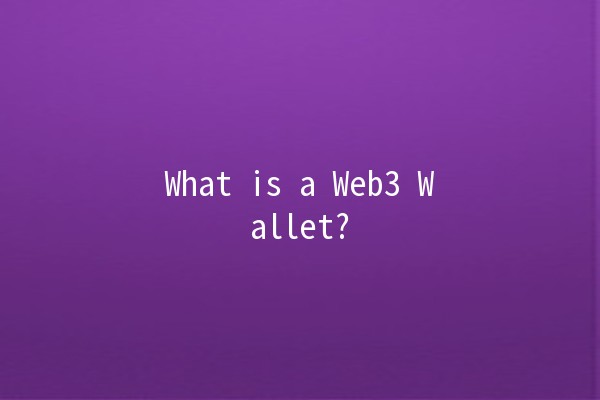
In recent years, the term "Web3" has become a buzzword in the digital landscape, particularly in relation to blockchain technology and decentralized applications (dApps). Central to the Web3 ecosystem is the concept of a Web3 wallet. This article aims to demystify what Web3 wallets are, how they function, and why they are essential for navigating the decentralized web.
Understanding Web3 Wallets
What is a Web3 Wallet?
A Web3 wallet is a digital wallet designed to manage your cryptocurrency and interact with blockchain networks. Unlike traditional wallets that store physical currency, Web3 wallets hold private keys that are essential for accessing and managing your cryptocurrencies. They enable users to send, receive, and track their digital assets seamlessly.
Core Features of Web3 Wallets

Types of Web3 Wallets
Web3 wallets can be broadly categorized into two main types: hot wallets and cold wallets.
Hot Wallets
Hot wallets are connected to the internet and are more suitable for frequent transactions. They are userfriendly and typically offered as browser extensions or mobile applications. Examples include:
MetaMask: A popular browser extension wallet that supports Ethereum and ERC20 tokens.
Coinbase Wallet: A mobile app compatible with various cryptocurrencies and dApps.
Advantages:
Easy to use for beginners.
Quick access to your funds and dApps.
Disadvantages:
Vulnerable to online attacks.
Cold Wallets
Cold wallets, on the other hand, are offline storage solutions designed for longterm storage of cryptocurrencies. They include hardware wallets and paper wallets. Examples include:
Ledger Nano X: A hardware wallet that supports a wide range of cryptocurrencies.
Trezor: Another popular hardware wallet known for its robust security features.
Advantages:
High security against online threats.
Disadvantages:
Less convenient for everyday transactions.
Why Use a Web3 Wallet?
Using a Web3 wallet offers several benefits:
Productivity Tips for Using Web3 Wallets
Explanation
To effectively manage your assets in a Web3 wallet, it's important to categorize them.
Application Example
Consider labeling your assets based on their purpose, such as longterm investments, trading assets, and NFTs. This organization will help you monitor and evaluate your portfolio more accurately and can assist in making timely trading decisions.
Explanation
Regular backups are crucial to safeguard your assets.
Application Example
Use external storage solutions to save your seed phrases and private keys. Make sure this information is stored securely and offline to minimize the risk of theft.
Explanation
Keeping your wallet's software updated improves security and adds new features.
Application Example
Enable automatic updates for your wallet application (if available) or periodically check for updates manually. This practice ensures you benefit from the latest security protocols and features.
Explanation
Community forums are valuable resources for learning about new trends and best practices.
Application Example
Join forums such as Reddit, Discord, or dedicated cryptocurrency communities to learn from experienced users. Engaging with others can provide insights into optimizing wallet usage and staying ahead of risks.
Explanation
Multisignature wallets add an extra layer of security.
Application Example
If you're managing a significant amount of assets, consider using a multisignature wallet where multiple keys are required to authorize a transaction. This feature protects your funds from unauthorized access.
FAQs
Hot wallets are online wallets that are easily accessible for daily transactions, while cold wallets are offline, providing enhanced security against hackers. For regular users, hot wallets offer convenience; however, for those holding significant assets longterm, cold wallets are recommended for maximum security.
Yes, as long as you have backed up your seed phrase or private keys. This recovery information allows you to create a new wallet and retrieve your assets. It’s crucial to keep this information safe and confidential, as anyone with access to it can control your assets.
Most Web3 wallets are free to set up and use. However, you will incur transaction fees (often called gas fees) for performing operations on the blockchain, which can vary depending on network congestion and the complexity of the transaction.
When choosing a Web3 wallet, assess features such as security protocols, user experience, supported assets, and integration with dApps. It's also beneficial to read user reviews to gauge reliability and performance.
Using a Web3 wallet can be safe, provided you follow best security practices, such as using hardware wallets for significant amounts, enabling twofactor authentication, and conducting due diligence on any wallet you choose.
Yes, many users maintain multiple Web3 wallets for different purposes, such as using one for trading and another for longterm storage. Diversifying your wallet options can enhance security and improve asset management.
By exploring Web3 wallets, you unlock a world of possibilities in the decentralized landscape, empowering you to take control of your digital assets and engage with emerging technologies. Dive deeper into the world of Web3, and take advantage of the revolutionary opportunities it offers!

